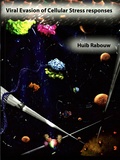Viral evasion of cellular stress responses

Rabouw, Huib
- Promoter:
- Prof.dr F.J.M. (Frank) van Kuppeveld
- Co-promoter:
- Dr R.J. (Raoul) de Groot & dr M.A. (Martijn) Langereis
- Research group:
- Kuppeveld
- Date:
- February 4, 2020
- Time:
- 12:45 h
Summary
For many viruses, efficient replication is contingent on the ability to evade antiviral responses such as the ISR. Yet, for most viruses it remains poorly understood by what mechanisms the ISR is suppressed. In this thesis we set out to identify new ISR antagonists encoded by picorna- and coronaviruses, and on the elucidation of their molecular mode of action. This will increase our knowledge about evasion mechanisms employed by viruses to protect themselves against antiviral responses. From a cell biological perspective, the study of viral ISR antagonists may also teach us more about how the ISR regulates translation, one of the core processes in life. In chapter 2, we set out to investigate the function of an accessory protein (p4a) encoded by Middle-East Respiratory Syndrome coronavirus (MERS-CoV) as inhibitor of PKR-mediated ISR activation(91). We identify MERS-CoV p4a as a PKR-specific ISR antagonist that functions via dsRNA binding. Consistent with its mode of action of dsRNA sequestration, p4a also prevents the activation of another dsRNA-activated antiviral pathway, the type I IFN induction pathway. While the mode of action of p4a was described before for several viral dsRNA binding proteins, p4a is the first coronavirus protein identified with this function. In chapter 3, we assess the function of a small-molecule inhibitor of the ISR (ISRIB). We observed that ISRIB prevents ISR activation only early in infection, but failed to do so at later time points. Further investigation taught us that ISRIB prevents ISR activity only under conditions of mild stress, as defined by a limited level of eIF2 phosphorylation. High levels of p-eIF2 however may inhibit translation and enhance expression of ISR-induced proteins, even in the presence of ISRIB. Thus, ISRIB makes cells less sensitive rather than insensitive to ISR signaling. These findings are consistent with the previously reported mode of action of ISRIB, and may explain the remarkable absence of side-effects of an ISRIB treatment in vivo. In chapter 4, we investigated the function(s) of an accessory protein, AcP10, encoded by Beluga whale coronavirus. AcP10 prevents p-eIF2 from binding its target eIF2B, and thereby AcP10 ensures that eIF2B remains active even in the presence of p-eIF2. It does so via a direct interaction with eIF2B, likely at an area that overlaps the interaction site for p-eIF2, but not for native eIF2. This mode-of-action was not previously described for any viral or host cell protein, and thus AcP10 is a prototype of an entirely novel class of ISR antagonists. We classified AcP10 as a Class 4 antagonist. In chapter 5, we describe another Class 4 antagonist, the Leader protein encoded by the picornavirus Aichivirus (AiVL). AiVL, like AcP10, binds eIF2B to prevent subsequent association of p-eIF2, thereby rescuing translation in the presence of (high levels) of p-eIF2 irrespective of the eIF2 kinase involved. Yet, AiVL has no homology to AcP10. Thus, Class 4 ISR antagonists arose at least twice, in phylogenetically distinct virus families, by convergent evolution.